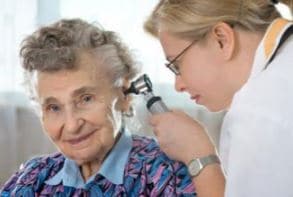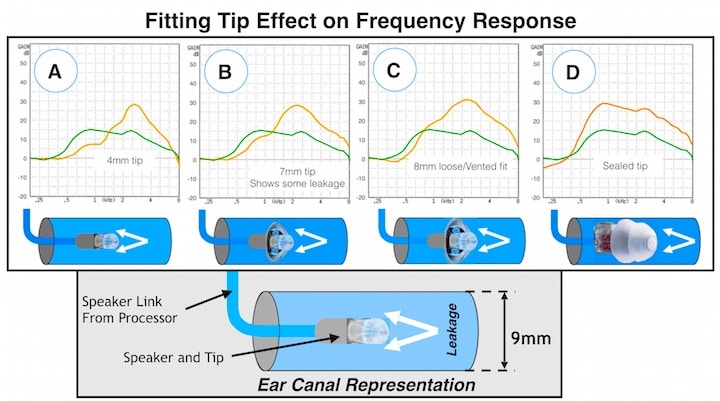Editor’s Note: Today’s post continues the discussion by Abigail Farmer and Bruno Sarda on the evolution of hearing aid technology.
Implications and Policy Recommendations
The hearing aid market as we know it is ripe for disruption. On one hand, hearing aids are expensive. They rely on proprietary technology that does not necessarily “play well” with other technologies. Market penetration is weak and shows no sign of changing.1 On the other hand, related technologies have made very exciting developments in the fields of interconnectivity, multi-functionality, and more. This will continue a trend: historically, hearing aid technology has advanced via integrating and improving on existing technologies; it never depended on basic research to advance.2
When it comes to restoring lost functionality, more individuals with hearing loss should use hearing aids of some sort. This sounds simple, but adopting hearing aids at a greater rate than at present will not just “happen;” indeed, if past history is any indicator, this is extremely unlikely. Even so,the United States’ aging demographics demand action to ensure that individuals with hearing loss have access to hearing aids.
As a Level 1 technology, hearing aids work quite well: they allow individuals with hearing loss to regain not just hearing function, but their place as active members in society. As a Level 2 technology, however, hearing aids are markedly less successful. One need only turn to the abysmal (and unchanging) adoption rates to see this.
The major factors preventing widespread hearing aid adoption are cosmetic concerns and prohibitive costs due to over-engineered devices, inefficient distribution due to archaic regulations, high labor costs, and excessive manufacturing costs due to a lack of industry standards.3
Together, these factors have created a system that is difficult to navigate and costly to participate in.
Recommendations

Our recommended solution takes a multi-pronged approach. First, we recommend that Congress pass the Seniors Have Eyes, Ears, and Teeth Act and make assistive hearing devices covered under Medicare. To be sure, this step would increase the costs of an already costly entitlement system. Even so, the fact remains that hearing aids are not really optional for individuals looking to remain active members of society.
Given that hearing loss can cause depression, damage relationships, and generally impede an individual’s ability to function in society, hearing aids are perhaps not as elective as one might previously have thought. With individuals living longer, the importance of treating hearing loss to facilitate continued social engagement is increasingly important.”4
Moreover, adding Medicare coverage could create additional pressure to implement our next recommendation: relax hearing aid distribution regulation to make hearing aids less costly.
Although it is unlikely that the FDA will declassify hearing aids as medical devices, the fact remains that this classification was a policy decision made nearly forty years ago and may not reflect current technology. As London cab drivers are facing the pressure of that comes from Uber’s replacing barriers to entry, so too is the hearing aid industry facing pressure from PSAPs.5
In a recent research initiative, however, the NIH has begun exploring the barriers to hearing aid adoption, including social stigma, socio-economic factors, and availability of subsidies.6 The NIH’s further research goals include identifying affordable, innovative technologies that will increase adoption, even if this means promoting less than cutting edge technology.7
This focus addresses the problem of over-engineered hearing aids; after all, most individuals with hearing aids use only a fraction of the device’s features.8 This is nonsensical: individuals with hearing loss do not need to experience upselling from their hearing aid dispensers; they should be able to select the device that best meets their needs—no more, no less.
The NIH’s pragmatic approach is promising; it shifts research focus from regulated and costly devices to simple solutions that meet an individual’s listening needs to improve day-to-day life. It is in this area that PSAPs will shine; they offer a broad spectrum of features at a range of affordable prices. PSAPs are also considered more stylish than an average hearing aid, which increases their likelihood of adoption.
*Stay tuned for the concluding statements in Part 12. Images courtesy cnn
References
- Wayne Staab, Hearing Aid Obituary: Continued. HearingHealthMatters.org (Dec. 1, 2014).
- Interview with Wayne Staab, supra note 15.
- Id.
- Wallhagen, supra note 72, at 66.
- Karla Adam, The Rise of Uber Means Less Love for London’s Traditional Black Cabs, Wash. Post (Dec. 31, 2015).
- Department of Health & Human Services, (last visited Apr. 25, 2016).
- Id.
- Interview with Wayne Staab, supra note 15.

Abigail Farmer graduated summa cum laude with B.A.s in French and Spanish from Texas A&M University. Before starting law school, she interned with the U.S. Commercial Service in Paris, France. Abigail served as Executive Note and Comment Editor for the Arizona State Law Journal from 2014–2015 and as the Hong Kong team editor for the Wilhem C. Vis International Commercial Arbitration Moot from 2015–2016. She also co-authored an article on bitcoins and estate planning, which won the Mary Moers Wenig Student Writing Competition and was published in the ACTEC Law Journal; she and her co-author presented the article at the Arizona State Bar Convention. Abigail is graduating summa cum laude with a J.D. from the Sandra Day O’Connor College of Law and with an M.B.A. from the W.P. Carey School of Business. After graduation, Abigail will join Shell’s legal department in Houston, Texas
 Bruno Sarda is a leading practitioner in the field of corporate sustainability at Dell, where he’s worked since 2005. In his role as Director of Social Responsibility, he leads the company’s strategy on social aspects of sustainability, including human rights and labor practices, working with internal and external stakeholders. He also manages Dell’s groundbreaking partnership with Phoenix-based TGen (Translational Genomics Research Institute) to accelerate adoption of precision medicine in addressing childhood cancer. In addition, Sarda is an adjunct faculty member and Senior Sustainability Scholar at Arizona State University, where he teaches and helped design and launch the Executive Master’s for Sustainability Leadership working with the Rob and Melani Walton Sustainability Solutions Initiatives at ASU.
Bruno Sarda is a leading practitioner in the field of corporate sustainability at Dell, where he’s worked since 2005. In his role as Director of Social Responsibility, he leads the company’s strategy on social aspects of sustainability, including human rights and labor practices, working with internal and external stakeholders. He also manages Dell’s groundbreaking partnership with Phoenix-based TGen (Translational Genomics Research Institute) to accelerate adoption of precision medicine in addressing childhood cancer. In addition, Sarda is an adjunct faculty member and Senior Sustainability Scholar at Arizona State University, where he teaches and helped design and launch the Executive Master’s for Sustainability Leadership working with the Rob and Melani Walton Sustainability Solutions Initiatives at ASU.







